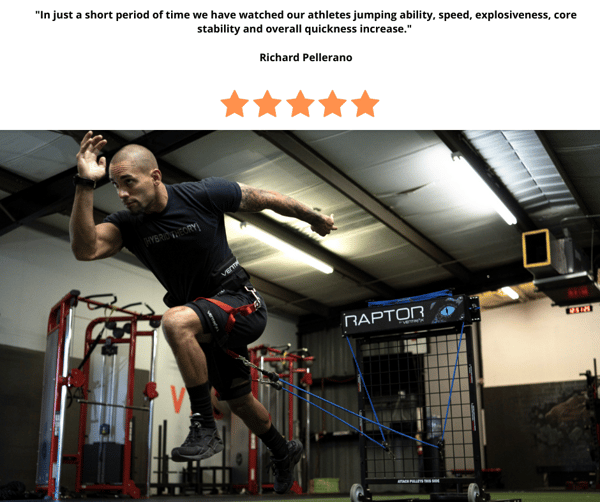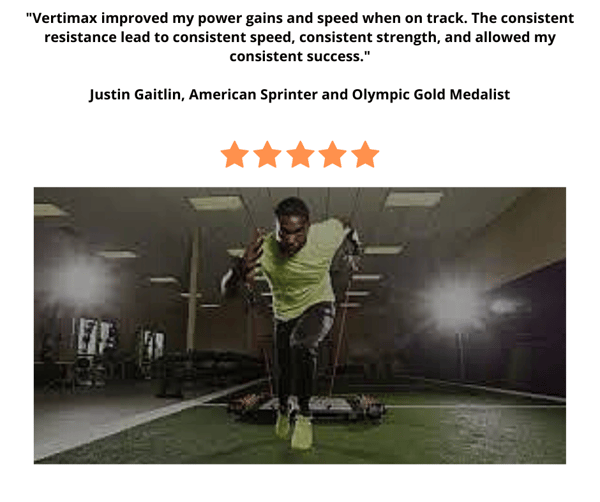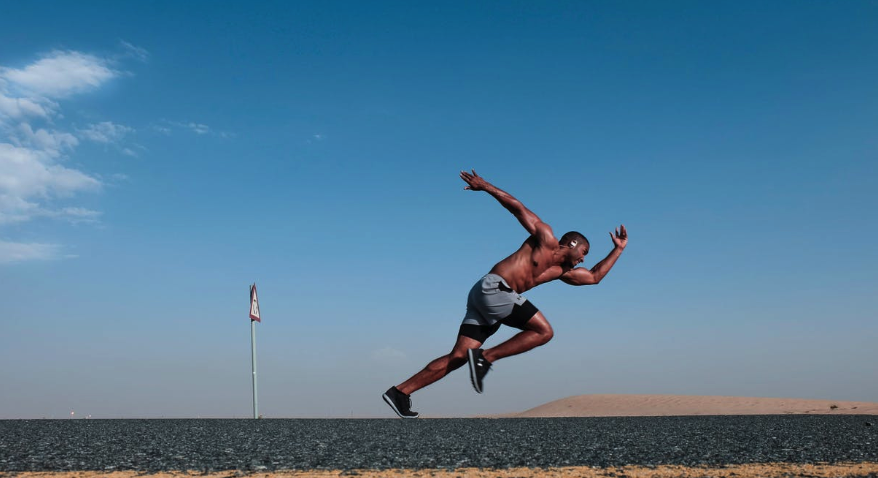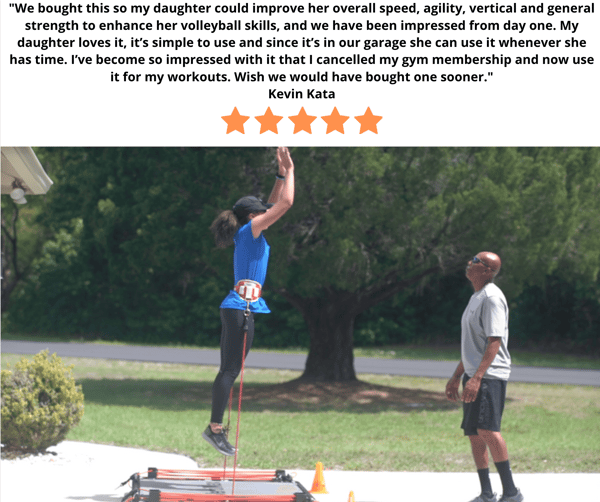There’s a science to learning how to run faster. Regardless of age, size, or skill level, anyone is capable of improving their personal speed record. There’s a lot of benefits that come with running speed. Running faster not only allows athletes to post noteworthy times in try-outs, during competition and in games, it also creates a more versatile athlete.
There’s a lot of benefits that come with being fast. Running faster not only allows athletes to post noteworthy times in try-outs, during competition and in games, it also creates a more versatile athlete. Whether you’re a basketball player, football player, soccer player or a track athlete, you need to be quick. Often, speed can mean the difference between a loss and a win.
Speed encompasses much more than the 50-yard dash. Unlike a track athlete, most sports require that a player be just as quick during lateral movements.
Whether you’re Usain Bolt dominating the sprinting competition or Gareth Bale traveling the field as swiftly as the ball, these impressive displays of athleticism show exactly what the human body is capable of. Lluckily, you don’t need to be one of the top athletes in the world to master the science of running faster.

What’s the science and physiology behind running fast?
Apart from being powerful and having good technique when running, you need to develop physical and mental capabilities to run fast. Studies suggest that genetics, muscle response, and cardiovascular system development all play a part in the science and physiology of running, as does specific training, which is a necessity for even champions like Bolt to bring out their best.
Are there distinct types of running in sports?
Four distinct types of running found in sports include lateral (moving forward and backwards) and liner (moving sideways), sprinting (running fast over a short distance) and long-distance (running slow over a longer distance). These styles of running are in most sports such as hockey, football, basketball and tennis, where standing, walking, jogging, and high-intensity sprints and endurance are needed to compete well in a game.
The Evolution of Running
Turning back the history clock, running, along with training and timing techniques have evolved significantly. Competitive running dates back the Irish Tailteann Games which began in 632 B.C and the modern Olympic Games, still held today, which derived from ancient Greece in 776 B.C However, training to run started with pedestrianism… or going for a walk. Ancient Greece competitors in pedestrianism were considered more as power-walkers rather than actual runners. Back then, race timing never existed. Instead, it was a case of who crossed the line first.
Running Training from the Mid 1700s to Today
Pedestrianism, as a sport, officially came into force in the mid-1700s. Robert Barclay Allardice, a businessperson, known as Captain Barclay due to his service in the Napoleonic Wars, became the first notable pedestrian. Captain Barclay’s training consisted mostly of walking over 20-24 miles daily, with a short half mile run early morning, and a dash mid-evening. Once a week the Captain wore heavy clothing and sprinted over 4 miles to activate the process of “sweating”.
By the 1900s, training consisted of walking, slow running, and short bouts of sprinting that would later become known as interval training. A notable runner of this era being Clarence DeMar, who trained over 100 miles weekly and won the Boston Marathon seven times. This form of training then developed with Paavo Nurmi, nicknamed the “Flying Finn” due to his ethnicity. Over his career, Nurmi claimed nine gold medals, and three silver, in the 1920, 1924 and 1928 Olympic Games and set a 10,000m world record of 30:06 and 5,000m world record of 14:28.2. During this era, electronic timekeeping first appeared, when Heuer, the Swiss watch manufacturer, introduced the chronometer later superseded by the Longines pocket stopwatch, then Magic Eye technology and Scan-O-Vision.
Throughout the 1900s interval training continued to evolve, until the distance backlash of the 60s and 70s where Arthur Lydiard, a New Zealand coach of Olympic dynamo Peter Snell, winner of three golds, introduced endurance training. This form of training combined running long-distance with drills, strides and form work to develop speed and a strong aerobic base. Running greats during this era included Steve Ovett, who followed aerobic development and Sebastian Coe, who enjoyed high intensity training. During the late 1990s Championship, a Netherland tech company, introduced RFID race timing technology based on radio frequency.
Vo2 Max training and thresholds, as well as the science behind running that we know today, began in the late 1980s and 90s and have evolved ever since. Today’s world record holders such as Usain Bolt, who broke the 100m (9:58) and 200m (19:19) world records, are faster and stronger, but much of their training principles still center on pedestrianism. Race timing technology has also advanced with Omega introducing the electronic starting pistol and the Quantum Timer, with a millionth of a second accuracy.
The Science of Running Faster
The science of running faster hinges on the mechanical, neurological, muscular and neuromuscular capabilities of the human body, as well as the mental and physiological aptitude of an individual to perform in various environments. But what exactly are each of these aspects and how do they help an athlete perform better when running?
Mechanical Capabilities and Running
The study of human mechanics - the skeleton, muscles, and joints - in motion is the biomechanics of movement, where science applies laws to understand forces. For instance, a recent study conducted on Usain Bolt, the 100-meter world record sprinter, used kinematics and kinetics, movement laws, to define how the 6ft 5in Jamaican’s mechanics exerted power and energy in the 2009 Olympics. Using real-life International Association of Athletics Federation (IAAF) data, physicists estimated Bolt generated 81.58kJ of energy during his sprint, with over 90% of this used to overcome drag, and yet, he still broke the world record. Apart from being tall and lean, Bolt’s mechanical attributes such as shape, muscle strength and leg length all contributed to his success.
When asked about world-class sprinter mechanics, Dr Alan Neville from the University of Wolverhampton said, “The body shape of male sprinters seems to have changed. Taller, more linear individuals are emerging as the better sprinters.”
Running and Neurological and Neuromuscular Attributes
Your neurological system initiates movement in the body and consists of the central nervous system (CNS), the brain and spinal cord, and the peripheral nervous system (PNS), the sensory and motor receptors. This system acts like a computer program telling your muscles to respond in a specific sequence, known as coordination, or the ability to turn on and off muscle response, which is controlled by the neuromuscular junction. The neuromuscular junction is where the central nervous system connects with muscle fibers. As with any other system in the body, studies show that the neurological system and neuromuscular control improves with training. One study comparing sprinters to long distance runners found that both neuro-systems in sprinters were quicker another focusing on neural influences when sprinting noted that neurological response times improve with training, as did muscle sequencing at the junction.
When asked about improving neurological and neuromuscular function, running coach Mike Antionades said, “The more you run in a certain way, the greater the number of neurons that attach to the muscle, the stronger the connection becomes, the quicker the messaging goes to the brain, the more muscles get recruited, the faster the movement.”
Muscular and Physiological Movement and Running
The human muscular system assists the body to move when running, regulates blood flow and heart and lung movement, as well as maintains posture and generates heat. Physiology, on the other hand, is the study of the organs within the body and their function when put under load or challenged. When under load, the body’s blood saturation or VO₂ max levels fall, and this increases lactate levels that inhibit muscle function. Thus, the muscular system interrelates with physiological movement. For example, a study on field-based team sports found the physiological characteristics of short duration sprinting and repeated sprinting differed. Higher VO₂ levels surfaced after 30-40m sprints compared to 15m trials, post-test lactate was also lower in the 15m trials, signifying the impact on the muscular system over long durations of activity.
When asked about muscular and physiological movement, Ithaca College sports science researcher Paul Geisler, warns that strength training goals in sports should look beyond building muscle mass. “If you focus too much on just size,” said Giesler, “you can risk compromising or losing some flexibility and elasticity of those muscles. It’s about coordination and balance and the interrelationship between all those muscles that allows players to prevent injury and perform well.”
Running, Mental Determination and Focus and Environmental Factors
Apart from looking to build mental determination to overcome fatigue when running, it’s important to develop hand-eye coordination, and also motor skills that enable you to negotiate obstacles when in full flight. A recent study highlighted this when it looked at the effects of long distance running on cognitive ability and then compared these findings to non-athletes. Results showed a distinct difference in cognition and motor skills, with the athletes having greater functionality even in a resting state. Thus, running gives you the capacity to improve your cognitive ability, as well as supports your motivation and strengthens your capacity to cope with physical and mental duress, not just during competition, but also in life.
Having strong cognition also helps you to overcome challenges, especially when your confronted with tough environmental factors such as UV exposure, heat exhaustion, altitude, pollutants, and rough terrain. A study focusing on 60 marathon races from 2001 to 2010 with over 1.7 million participants highlights how environmental factors such as air temperature and atmospheric pressure impact on running speeds and withdrawal rates. However, those competitors with impressive mental strength pushed on to complete the marathon.
When asked about mental focus in extreme environmental conditions, Kirti Bhoir one of six runners embarking on a 22-hour marathon from Pune to Mumbai, in India, said, “We had no mental conditioning on this route, so it was completely fresh, and our minds had to be active the whole time we were running adding to fatigue.” The environmental factors the six runners encountered included traffic, livestock, an unfamiliar route, spectators, the heat, and sleep deprivation.
How to Train to Run Faster
1. Understand the Difference Between Power and Strength
First and foremost, every coach and athlete should have a solid understanding of the difference between power and strength if they want to have an effective speed training program!
Strength, in the simplest sense is a measurement of absolute force output or how much force an athlete can generate and we often don't care how fast the force is generated. Have you ever seen a coach use a stop watch to time a max bench press or squat? Of course not. We don't care how fast the athlete moves the weight or how long it takes to complete the rep, we just care if the athlete generates enough force to get the weight up and complete the rep.
Power, the more valuable commodity in athletics is a measurement of the rate at which force is generated. The faster we generate force, the faster we accelerate that's physics pure and simple. Do not make the mistake of assuming low speed strength gains (squats & bench press max gains in the weight room) are going to automatically make you more explosive and bring high speed power gains in competition. Slow moving heavy lifts will develop your ability to generate more force (get you stronger) but they are not optimal for developing your ability to generate force faster. Light load, high speed, explosive training is the optimal way to convert those strength gains in the weight room to power gains and run faster in competition! Use of elastics is a great way to conduct light load, high speed training but conventional elastics have a lot of drawbacks but that's why Vertimax was created, to solve those problems and make speed training with elastics much more effective.
2. Optimize Speed and Quickness
An athlete's speed & quickness is primarily a function three things. If you want great speed training results you need to focus on optimizing these three things:
A) Force and Acceleration - The ability to quickly apply significant force to the ground and accelerate the body when the foot is planted on the ground and driving.
B) Foot Acceleration - The ability to accelerate the foot when it breaks contact with the ground and enters the swing phase so the foot can achieve higher velocities and reduce the amount of time to reach the next ground strike point. This will reduce the amount of time both feet are airborne and allow the athlete to begin driving again on ground strike to continue the acceleration process. VertiMax was designed to provide unsurpassed speed training gains in both (a) & (b) above.
C) Proper Running Technique - Utilization of proper running technique to most efficiently utilize movement and power to promote acceleration to run faster is critical. Depending on your level of competition, a speed coach qualified in the analysis and improvement of running form may be recommended as a coach well trained to correct and improve running technique can deliver significant speed training improvements quickly.
3. Increase Velocity and Explosive Movement
When it comes to speed training, there's two important components athletes need to make sure their training includes. Those two critical components include training to improve high velocity power production and the study of proper running technique and stance from which to initiate explosive movements. Though not mentioned, conducting the appropriate Core & Functional training to facilitate high speed explosive movement and injury prevention are important aspects of any athletic training program. If you are considering hiring a speed trainer, here are some important things to know and potentially ask that person prior to paying them for a speed training service.
How to Hire a Speed Trainer or Coach
A) Ask the speed trainer what drills and exercises his workouts consist of before you hire them. You want to make sure the majority of the training actually applies to your goals! One of the most common issues we see with speed training programs offered by speed trainers is the vast majority of the training exercises are agility related as opposed focusing on developing power to improve acceleration. If you're trainer does not have any or many drills allowing you to conduct light load explosive training utilizing a LOW MASS form of resistance in addition to your own body weight, I can assure you that you are not going to fully develop your speed potential with that speed trainer. Almost all exercises that are designed properly have some benefit, but never forget to question relevance of an exercise as it relates to what you want to accomplish. A perfect example of one of the most over used, minimally effective drills used by speed trainers is the infamous ladder drill. The ladder drill certainly has some benefits for eye – foot coordination at high speeds which would be of great benefit for a soccer player. However, how many basketball, football or baseball players have you ever seen running around the field in the middle of a play mimicking a ladder drill with their feet? I bet you've never seen one. That is what we are talking about we you want to examine training relevance as it pertains to your goals. Ladders are very inexpensive products and look great when athletes are using them but they have very practical application in most sports and most importantly speed development.
B) When interviewing a speed trainer about how they intend to make you run faster, ask them how they intend to develop DRIVE AND SWING PHASE power. To improve Drive power they need to explain to you how they are going to increase explosive power in the quads, gluts and calves. To develop Swing phase power they need to have a solid plan for developing the explosive power of the hip flexors, abductors and adductors. If they tell you they are going tie an elastic band between your ankles and have you do a shuffle or high knee drive to develop hip flexor power or abductor/adductor power, ask them how they intend to develop explosive power at the beginning of those movements (where its most important for acceleration) when that elastic band is slack and provides no load on the muscle until it is 50 to 80 percent of the way through the range of motion when that band between the ankles finally tightens up. You'll get a blank stare from 90% of speed trainers on this one.
C) Speed training with elastics is a great way to develop explosive power utilizing high speed sports specific movements. However, NEVER FORGET THAT IF AN ELASTIC BAND TIED TO ANY PART OF YOUR BODY IS SLACK AND NOT PROVIDING ANY USEFUL LOAD WHEN YOU INITIATE THE EXPLOSIVE MOVEMENT – YOU WILL NOT BE DEVELOPING POWER AT THE BEGINNING OF THE MOVEMENT WHERE POWER PRODUCTING IS MOST IMPORTANT FOR ACCELERATION! If you watch the videos above it is this exact issue with conventional elastic training methods that the VertiMax system has solved to provide the best speed training power gains possible for radically improving your vertical and for linear and lateral acceleration to run faster.
D) Don't get stuck in traditional training ruts. A lot of old training methods can be augmented or even replaced by VertiMax technology. Traditional speed and performance training consists mainly of weight training, plyometrics, speed and agility drills, running with parachutes and pulling sleds. All these exercises focus primarily on over loading and improving the power producing capabilities of the quads, glutes and calves, the muscles that provide driving power when our foot is planted on the ground and pushing. That's great for developing power to increase our drive velocity and speed when the foot is planted on the ground. However, when your foot leaves the ground, how fast it can accelerate in the direction you are running (Swing Phase) and make ground contact to drive again, is the other half of the speed equation that will dictate if you can run faster.
Power to generate airborne foot speed will greatly impact how fast you are! And guess what? The muscles that provide the power to accelerate the airborne foot are NOT the quads, glutes and calves they're the hip flexors, abductors and adductors. If you do not allocate training time appropriately and effectively to those muscle groups, you will never reach your full speed potential. Unfortunately for most athletes, traditional speed training protocols do not over load and target the hip flexors, abductors and adductors to improve their power producing capabilities. That is not a good thing if you are trying to improve your speed. Think about it, when you consider all your speed training protocols, when do you apply a resistance to your airborne foot? If you are like most athletes the answer to that question is unfortunately "never". Which basically means you can be significantly faster than you are now.
Training For Specific Sports
All sports differ, so athletes need to have varying levels of fitness to be competitive. A basketball athlete will have different skills and body composition to a track and field athlete, as will a footballer. For example, if we look at body fat percentage as a measurement of fitness, we’ll discover that a track and field athlete will have a far lower body fat percentage than a professional footballer. But what are the exact athletic needs of these and other sports?
Basketball
Basketball athletes travel, on average, over 2.55 miles in a game. Given this distance, basketball players need good cardiovascular fitness, along with anaerobic power, and muscular strength and endurance. Following a combined program that includes strength, agility, blocking, drills, and conditioning will effectively increase your skills for game-play.
Football
According to a study central midfielders run less than 8 miles per game, with strikers and defenders running 6 miles, and goalkeepers around 3 miles. Therefore, footballers need to be powerful, as at an elite level they typically run 40-yard dash in around 4.3 seconds. Therefore, for footballers to be competitive, they need to work on their conditioning to produce greater speed when running. The ideal way to increase speed is through metabolic training, which takes a player’s lateral and backward game movements during play into consideration so that they build strength and power in the required muscles to produce greater speed. By using a metabolic running program that simulates quarters, this is achievable.
Soccer
Running an average of 7 miles per game, soccer players need an elevated level of fitness to play well. Soccer players tend to be lean, and have an excellent cardiovascular system. Plus, they are quick and flexible. But in terms of power apart from their legs, they don’t need much else. With soccer players changing direction during play and needing both sprint and endurance capabilities, it’s important to follow a training program that uses maximum aerobic speed and pushes a player to reach their VO₂ max.
Hockey
Research suggests that midfielders and forwards cover up to 8 miles per game, defenders travel up to 4 miles per match, while goalkeepers only cover around 1 mile. Hockey players need to be flexible and powerful, have good body composition, and high cardiovascular fitness to compete well. Conditioning in hockey is more than cardiovascular and muscle development; it also helps an athlete understand how to meet the energy demands of the sport. Tempo Runs are one of the best training programs for hockey conditioning.
Tennis
A study suggests that over an 11-hour 5-minute tennis game players covered 5.9 miles. However, the distance players cover can vary from match-to-match. With tennis matches lasting for hours and players darting in all directions to get to the ball, it’s important that athletes look to do a strength and conditioning program that focuses on interval, pace and tempo, and endurance training.
Track and Field
The distance traveled as a track athlete when competing depends entirely on whether you’re a short or long-distance runner. Sprinters will typically compete in 100m, 200m and 400m events, while long-distance runners will thrive when competing over 800m, 1600m and 3200m or in a marathon over miles. Therefore, following workouts that are relative to your preferred distance will help you to increase your muscle strength, power and response speeds, so that you can post competitive track times. Plus, they also build-up your levels of endurance.

Boost Running Performance with the Right Equipment and Drills
With over 650 muscles in the human body that control various aspects of movement, it’s difficult to know if you’re training the right muscles to dominate the competition. So rather than wasting hours doing drills that give you little or no benefit, use the right equipment and follow drills and invest in equipment that allow you to see improvements.
With speed, strength, and power being the main considerations in most sports, as well as endurance, players from all fields are looking to improve their capabilities in the least amount of time, so that they are competitive. However, finding the most effective way to do this, in a sport-specific context, is not a straightforward process. This scenario is when Vertimax, the only training system that applies resistance to athletes while they practice game-play movements, becomes a vital training component. Not only does Vertimax challenge mental, muscular, and physiological movement, but it also stimulates neurological and neuromuscular activity, as well as an athlete’s mechanical capabilities, regardless of their sporting pursuit.
Check out these leg exercises to increase running speed.
VertiMax for Maximum Acceleration and Speed Gains
Leave your 40-yard-dash competition behind when you drop your 40 using one of the most advanced speed training systems on the market. Using resistance to train all muscles during motion, you’ll develop the explosive power needed to get head-turning results. Get drills and exercises to increase running speed with the VertiMax App.






.png?width=110&name=Listing%20Image-basketball%20ladder%20drill%20%20(350%20x%20350%20px).png)













